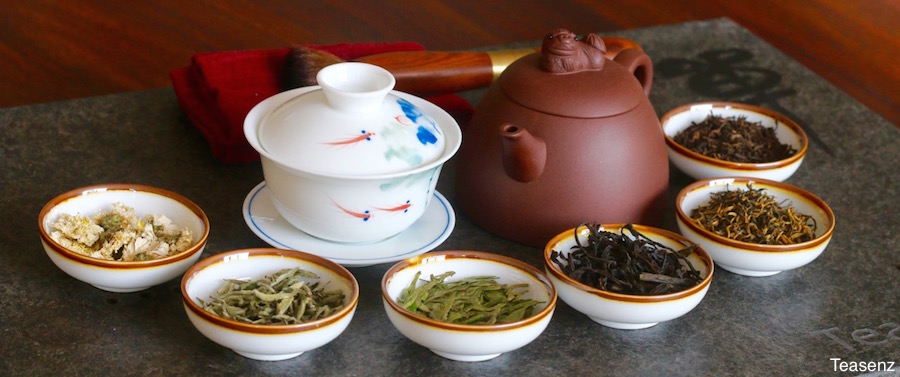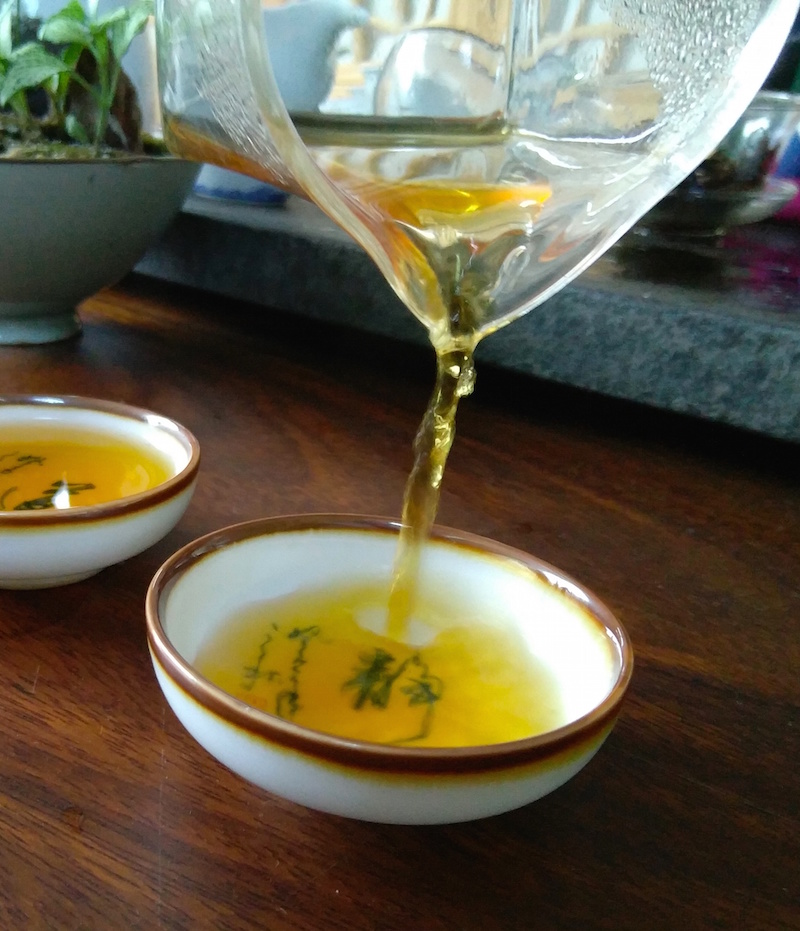In this article, we provide a simple step-by-step guide to steeping pu erh tea. Along side the basics, we’ll also introduce you some advanced concepts to further improve your brewing skills.
Teaware
Yixing Teapots & Gaiwans
The key to steeping a good cup of pu erh tea starts with picking suitable teaware. Both the gaiwans and Yixing teapots are excellent choices. They're great to brew small portions of tea, spread over many steeps. This allows you to experience the multiple layers of flavor, instead of tasting the ‘average’ tea flavor by brewing in a large teapot.

To know more about the comparison, read this article: Yixing versus Gaiwan
ADVANCED
- Age, Leaf Type & Teaware Choice: When you’ve both Yixing teapots and gaiwans at your disposal, we recommend to use a gaiwan to steep teas that are young in age and/or consist of tender buds. In contrast, you should use an Yixing teapot steep very old pu erhs and ones that are old in age and/or consist of larger leaves and stems. The idea behind this is that young and tender teas require less heat, while for older and less tender teas, isolation becomes more important.
- Improve Heat Isolation of GaiwansIn case you're brewing pu erh with a gaiwan, and require better isolation. There's a simple trick that you can apply: once you've added water in the gaiwan, you close the lid, and pour a small amount of water over the gaiwan lid. This will significantly improve the isolation. Do keep in mind that you could burn your hands, as the gaiwan edge is hotter than usual. Therefore, first nudge the gaiwan slightly to one side, to discard the water on top of the lid first, before you grab the gaiwan.
Tea pitcher
A tea pitcher (also known as 'cha hai' or 'gong dao bei') is essential when you're using gaiwans or Yixing teapots. The reason is simple: a tasting cup will fit less tea than that's inside the teapot. So if you pour directly into your cup, a part of the tea will stay inside the teapot for too long. By the time you pour yourself another cup, the tea is already too strong.
Even if you do have enough cups to distribute the tea, the first cup you pour will taste different from the last. So in any case a tea pitcher will be highly useful. We recommend a glass tea pitcher, as you'll be better able to observe the tea color.
Tea Cups
At last, you'll need some small Chinese cups, which fit about 50 ml of tea. When serving tea in smaller cups, the tea will cool down faster to an enjoyable temperature. Moreover, by drinking small portions of tea, will allow you to focus more and better evaluate the taste and aroma it has to offer.

A Tea Knife
In most of the cases, pu erh teas are often compressed in cakes, bricks or tuocha. Tea cakes are sometimes quite loosely compressed, so it's pretty easy to carefully break of a chunk without damaging the leaves. However, bricks and tuochas are often times pretty tight. For this you'll need a tea knife to pry of the leaves before you can start brewing.
Pu Erh Tea Steeping Guide
Leaf-to-water
There's no definite right answer to the amount of pu erh tea you should use. This depends a bit on the size of your steeping vessel, characteristics of tea tea you want to brew, and most importantly your personal preferences.
A general rule of thumb for seasoned pu erh tea drinkers is 8 grams of tea with 150 ml of water. However, this could result in a brew that is too strong for beginning tea drinkers. If you're just started to get into pu erh, 5 grams of tea may be more suitable to start with.
Water Temperature
To start brewing, prepare water at the right temperature. The definition of the 'right temperature' will depend on whether you're brewing ripe or raw pu erh, and the size of the leaves.
Pu erh tea that consists of smaller leaves and buds are generally appreciated for their delicate flavors. By applying slightly cooled down water, you'll be better be able to enjoy the delicate aromas, while balancing the bitter flavors. Lower water temperatures are also more suitable for young pu erh teas.
On the other hand, teas with more larger leaves and stems are generally smoother and they contain more sweetness. These leaves should be steeped with as much heat as possible. Use the below data as a reference:
- Ripe, large leaf: 100ºC
- Ripe, small leaf: 95ºC
- Raw, large leaf, >3 years old: 100ºC
- Raw, large leaf, <3 years old: 95ºC
- Raw, small leaf, >3 years old: 95ºC
- Raw, small leaf, <3 years old: 90ºC
For your reference it takes about 6 minutes to let water cool down from 100ºC to 90ºC. This of course also depends a bit on actual room temperature.
Rinsing
Once you've got water ready, you can put the preferred amount of tea in the vessel. A traditional brewing process starts with rinsing pu erh. This simply means that you should discard the first steep. The reason for rinsing pu erh is first and foremost to 'awaken' the leaves. This is particularly important for pu erh as they're often times compressed. Rinsing allows the tea to loosen up and unfurl somewhat, allowing for a more optimal brew. You can apply a rinsing time of 10 seconds.
ADVANCED:
- Rinsing Time & Leaf Size: Pu erh teas consisting of very small leaves often release flavor very fast, this is especially the case with ripe pu erh (gong ting grade). As these teas often hold less brewing sessions (about 7-9 steeps), you should instantly discard the first rinse to avoid spilling too much flavor.
- On the other hand, for teas that consist of larger leaves and stems, you can increase the rinsing time somewhat to about 15 seconds. The enjoyable flavors of such tea are often times in the deeper layers. You won't miss a thing by rinsing a bit longer. Even after a long rinse, you'll still be able to enjoy up to 15 steeps with such pu erh tea.
Steeping Time
When it comes to steeping time, this is often times more a matter of personal preference. If you've no clue about the steeping time, start off with a 10 second brew and see how the tea tastes. If you feel it's about right, then add 5 seconds for every subsequent brew. Of course, you may adjust the time along the way as you get more feedback about the specific tea that you're brewing. The most important indicator for determining the proper steeping time is the tea color, as some pu erh will release flavor faster than others.
Once you're determined specific brewing parameters, you may write it down on the wrapper/packaging to remind yourself the next time you brew this specific tea again.
ADVANCED:
- Pouring Technique: When pouring tea into the gaiwan, make sure to pour with a slow and controlled speed. When using a gaiwan pour along the edges. When you do it right, you'll see little movement of the tea leaves. This is particularly important with small delicate leaves. Fast pouring will negatively affect the delicate aromas and result in a less clear soup.
When you gently take care of the tea, the tea will take better care of you. This may sound very strange, but at some point, when you're a more experienced tea drinker, you'll notice the difference!
Last point, when you're brewing a tea with larger leaves and stems. You can somewhat increase the pouring speed. These teas need to be worked a bit to better unfurl. You're doing it right when you see the leaves rolling around in the gaiwan or Yixing teapot.
Serving & Tasting Tea
To serve the tea, slowly transfer the tea from the brewing vessel into the tea pitcher. Afterwards, you pour the tea from the pitcher into the tasting cups.
Before you taste the tea let it cool down to an enjoyable drinking temperature. We don't have to be too scientific about this, but the general rule is that you'll enjoy the tea the most at around 50 to 60ºC.
So wait at least 10 seconds before you start to sip. Instead of waiting, you can also observe the tea colour and smell the aroma to get an idea of what you're about to expect. It's a good practice to nurture your tea instincts!
At Last, Properly Store Your Pu Erh...
Once you're done enjoying your tea, make sure to carefully store the remainder of the pu erh for further aging. Aging is an important aspect of pu erh, and you should learn more about how to store pu erh properly if you aren't aware about it yet.